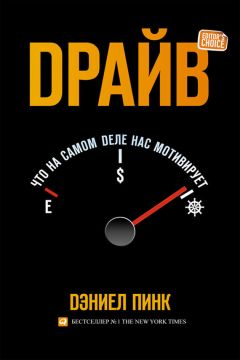Дэниель Пинк - Драйв: Что на самом деле нас мотивирует

Помощь проекту
Драйв: Что на самом деле нас мотивирует читать книгу онлайн
4
Харлоу в определенной степени стал частью научного истеблишмента. Он получил Национальную медаль за научные заслуги и стал президентом Американской психологической ассоциации. Чтобы узнать больше о жизни и работе Г. Харлоу, см.: Deborah Blum. Love at Goon Park: Harry Harlow and the Science of Affection (Perseus, 2002); Jim Ottaviani & Dylan Meconis. Wire Mothers: Harry Harlow and the Science of Love (G. T. Labs, 2007).
5
Edward L. Deci, «Effects of Externally Mediated Rewards on Intrinsic Motivation,» Journal of Personality and Social Psychology (1971). Vol. 18, p. 114.
6
Edward L. Deci, «Intrinsic Motivation, Extrinsic Reinforcement, and Inequity,» Journal of Personality and Social Psychology (1972). Vol. 22, p. 119–120.
7
«Important Notice: MSN Encarta to be Discontinued,» Microsoft press release (30 March 2009); Ina Fried, «Microsoft closing the book on Encarta,» CNET News (30 March 2009); «Microsoft to Shut Encarta as Free Sites Alter Market,» The Wall Street Journal (31 March 2009). Данные о Wikipedia см.: http://en.wikipedia.org/wiki/Wikipedia:About.
8
Karim R. Lakhani & Robert G. Wolf, «Why Hackers Do What They Do: Understanding Motivation and Effort in Free / Open Source Software Projects,» in Perspectives on Free and Open Software, edited by J. Feller, B. Fitzgerald, S. Hissam, and K. Lakhani (MIT Press, 2005), p. 3 and p. 12.
9
Jurgen Blitzer, Wolfram Schrettl, Philipp J. H. Schroeder, «Intrinsic Motivation in Open Source Software Development,» Journal of Comparative Economics, Vol. 35 (2007).
10
«Vermont Governor Expected to Sign Bill on Charity-Business Hybrid,» The Chronicle of Philanthropy, News Updates (21 April 2008).
11
Юнус М. Создавая мир без бедности. — М.: Альпина Паблишер, 2010. (Muhammad Yunnus, Creating a World without Poverty: Social Business and the Future of Capitalism. Public Affairs, 2007, p. 23; Aspen Institute, Fourth Sector Concept Paper. Fall 2008; «B Corporation,» MIT Sloan Management Review. 11 December 2008; http://www.bcorporation.net/declaration).
12
Stephanie Strom, «Businesses Try to Make Money and Save the World,» The New York Times (6 May 2007).
13
Colin Camerer, «Behavioral economics: Reunifying psychology and economics,» Proceedings of the National Academy of Sciences, Vol. 96, September 1999.
14
Bruno S. Frey, Not Just for the Money: An Economic Theory of Personal Motivation (Edward Elgar Publishing, 1997), p. 118–119. См. также: Bruno S. Frey & Alois Stutzer, Happiness & Economics (Princeton University Press, 2002).
15
Bradford C. Johnson, James M. Manyika, Lareina A. Yee, «The next revolution in interaction,» McKinsey Quarterly (No. 4, 2005).
16
См.: Дэниел Пинк. Новый мозг. Почему правое полушарие будет править миром?, «РИПОЛ классик», 2014 / Daniel H. Pink, A Whole New Mind: Why Right Brainers Will Rule the Future (Riverhead Books, 2006).
17
Theresa Amabile, Creativity in Context (Westview, 1996), p. 119. Амабайл также отмечает, что правильное и осмотрительное использование внешних стимулов может поощрять творчество. Подробнее я буду говорить об этом в главе 2.
18
Telework Trendlines 2009, данные подготовлены The Dieringer Research Group Inc и опубликованы WorldatWork (February 2009).
19
Твен М. Приключения Тома Сойера. — М.: АСТ, 2010. (Mark Twain, The Adventures of Tom Sawyer. Oxford University Press, 1998, p. 23).
20
Mark Lepper, David Greene, Robert Nisbett, «Undermining children’s intrinsic interest with extrinsic rewards: A test of the «overjustification» hypothesis,» Journal of Personality and Social Psychology. Vol. 28 (1973).
21
Edward L. Deci, Richard M. Ryan, & Richard Koestner, «A Meta-Analytic Review of Experiments Examining the Effects of Extrinsic Rewards on Intrinsic Motivation,» Psychological Bulletin. Vol. 125, No. 6 (1999)
22
Jonmarshall Reeve, Understanding Motivation and Emotion, fourth edition (John Wiley & Sons, Inc., 2005), p. 143.
23
Dan Ariely, Uri Gneezy, George Lowenstein, and Nina Mazar, «Large Stakes and Big Mistakes,» Federal Reserve Bank of Boston Working Paper No. 05–11 (23 July 2005). Краткий обзор этого и других исследований Дэна Ариэли можно найти в статье: «What’s the Value of a Big Bonus?» The New York Times (20 November 2008).
24
«LSE: When performance-related pay backfires,» The Financial (25 June 2009).
25
Sam Glucksberg, «The influence of strength of drive on functional fixedness and perceptual recognition,» Journal of Experimental Psychology, Vol. 63 (1962); Sam Glucksberg, «Problem Solving: Response Competition Under the Influence of Drive,» Psychological Reports. Vol. 15 (1964).
26
Theresa M. Amabile, Elise Phillips, & Marry Ann Collins, «Person and Environment in Talent Development: The Case of Creativity,» in Talent Development: Proceedings from the 1993 Henry B. and Jocelyn Wallace National Research Symposium on Talent Development, edited by Nicholas Colangelo, Susan G. Assouline, and DeAnn L. Ambroson (Ohio Psychology Press, 1993), p. 273–274.
27
Jean Kathryn Carney, «Intrinsic Motivation and Artistic Success,» The University of Chicago (unpublished dissertation, 1986); J. W. Getzels and Mihalyi Csikszentmihalyi, The Creative Vision: A longitudinal study of problem-finding in art (Wiley Interscience, 1976).
28
Theresa M. Amabile, Creativity in Context (Westview Press, 1996), p. 119; James C. Kaufman (ed) and Robert J. Sternberg (ed), The International Handbook of Creativity (Cambridge University Press, 2006), p. 18.
29
Richard Titmuss, The Gift Relationship: From Human Blood to Social Policy, Expanded and Updated Edition, edited by Ann Oakley and John Ashton (The New Press, 1997).
30
Carl Mellstrom & Magnus Johannesson, «Crowding Out in Blood Donation: Was Titmuss Right?» Journal of the European Economic Association. Vol. 6. No. 4 (June 2008).
31
В ходе другого исследования было обнаружено, что денежное поощрение оказывалось особенно неэффективным в том случае, если благотворительный акт носил публичный характер. См.: Dan Ariely, Anat Bracha, & Stephan Meier, «Doing Good or Doing Well? Image Motivation and Monetary Incentives in Behaving Prosocially,» Federal Reserve Bank of Boston Working Paper No. 07–9 (August 2007).
32
Bruno S. Frey, Not Just for the Money: An Economic Theory of Personal Motivation (Edward Elgar Publishing, 1997), p. 84.
33
Nicola Lacetera & Mario Macias, «Motivating Altruism: A Field Study,» Institute for the Study of Labor Discussion Paper No. 3770 (October 28, 2008).
34
Lisa D. Ordonez, Maurice E. Schweitzer, Adam D. Galinsky, & Max H. Braverman, «Goals Gone Wild: The Systematic Side Effects of Over-Prescribing Goal Setting,» Harvard Business School Working Paper No. 09–083 (February 2009).
35
Peter Applebome, «When Grades Are Fixed in College-Entrance Derby,» The New York Times (7 March 2009).
36
Uri Gneezy & Aldo Rustichini, «A Fine is a Price,» Journal of Legal Studies, vol. XXIX (January 2000).
37
Gneezy & Rustichini, p. 3 & p. 7 (выделено мной).
38
Anton Souvorov, «Addiction to Rewards,» презентация, представленная на European Winter Meeting Эконометрического общества, 25 октября 2003. Бюллетень доступен по адресу: http://www.cemfi.es/research/conferences/ewm/Anton/addict_new6.pdf.
39
Brian Knutson, Charles M. Adams, Grace W. Fong, and Daniel Hommer, «Anticipation of Increasing Monetary Reward Selectively Recruits Nucleus Accumbens,» The Journal of Neuroscience. Vol. 21 (2001).
40
Camelia M. Kuhnen and Brian Knutson, «The Neural Basis of Financial Risk Taking,» Neuron. Vol. 47 (September 2005).
41
Mei Cheng, K. R. Subramanyam, Yuan Zhang, «Earnings Guidance and Managerial Myopia,» SSRN Working Paper. No. 854 515 (November 2005).
42
Lisa D. Ordonez, Maurice E. Schweitzer, Adam D. Galinsky, & Max H. Braverman, «Goals Gone Wild: The Systematic Side Effects of Over-Prescribing Goal Setting,» Harvard Business School Working Paper. No. 09–083 (February 2009).
43
Roland Benabou and Jean Tirole, «Intrinsic and Extrinsic Motivation,» Review of Economic Studies. Vol. 70 (2003).
44
Edward L. Deci, Richard Koestner, & Richard M. Ryan, «Extrinsic Rewards and Intrinsic Motivation in Education: Reconsidered Once Again,» Review of Educational Research. Vol. 71. No. 1 (Spring 2001).
45
Dan Ariely, «What’s the Value of a Big Bonus?» The New York Times (20 November 2008)
46
Theresa Amabile, Creativity in Context (Westview, 1996), p. 175.
47
Deci, Ryan, and Koestner.
48
Theresa Amabile, Creativity in Context (Westview, 1996), p. 117.
49
Deci, Ryan, and Koestner.
50
Amabile, p. 119.
51
Richard M. Ryan & Edward L. Deci, Self-Determination Theory and the Facilitation of Intrinsic Motivation, Social Development, and Weil- Being, American Psychologist. Vol. 55, January 200, p. 68.
52
Meyer Friedman, M. D. & Ray H. Rosenman, M. D., Type A Behavior and Your Heart (Alfred A. Knopf, Inc., 1974), p. 4.
53
Friedman & Rosenman, p. 70.
54
Douglas McGregor, The Human Side of Enterprise: 25th Anniversary Printing (McGraw-Hill, 1985), p. 33–34.
55
Ryan & Deci, American Psychologist (January 2000).
56
Edward L. Deci and Richard M. Ryan, «Facilitating Optimal Motivation and Psychological Well-Being Across Life’s Domains,» Canadian Psychology, Vol. 49, No. 1 (Feb. 2008).
57
Valery Chirkov, Richard M. Ryan, Youngmee. Kim, & Ulas Kaplan, «Differentiating autonomy from individualism and independence: A self-determination theory perspective on internalization of cultural orientations and well-being,» Journal of Personality and Social Psychology, Vol 84 (January 2003). Joe Devine, Laura Camfield, and Ian Gough, «Autonomy or Dependence — or Both? Perspectives from Bangladesh,» Journal of Happiness Studies. Vol. 9. No. 1 (January 2008).
58
Deci & Ryan, Canadian Psychology.
59
Paul P. Baard, Edward L. Deci & Richard M. Ryan, «Intrinsic Need Satisfaction: A Motivational Basis of Performance and Well-Being in Two Work Settings,» Journal of Applied Social Psychology. Vol. 34 (2004).
60
Francis Green, Demanding Work: The Paradox of Job Quality in the Affluent Economy (Princeton University Press, 2006).
61
«Atlassian’s 20% Time Experiment,» Atlassian Developer Blog, post by Mike Cannon-Brookes on 10 March 2008.
62
Цит. по: Harvard Business Essentials: Managing Creativity and Innovation (Harvard Business School Publishing Company, 2003), p. 109.
63
Цит. по: Ben Casnocha, «Success on the Side,» The American: The Journal of the American Enterprise Institute (April 2009). Прекрасный анализ принятой в компании 3M практики приводится в кн.: Коллинз Д., Поррас Д. Построенные навечно. — М.: Манн, Иванов и Фербер, 2005. (James C. Collins & Jerry L. Porras, Built to Last: Successful Habits of Visionary Companies. Harper Business Essentials, 2002).
























